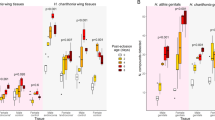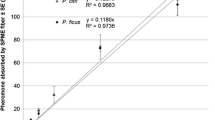Abstract
Body size, age, ambient temperature, wing wear, and flight activity were investigated as possible sources of variation in the quantities and relative proportions of the three chemical components [n-heptacosane (C27), 13-methylheptacosane (13MH), andn-nonacosane (C29)] of the male courtship pheromone ofColias eurytheme butterflies. Size of the male has very little influence on the amount of any of the pheromone components present on the wings. Most of the deposition of all three components onto the surface of the hindwing occurs between 3 and 9 hr after emergence from the pupa. 13MH is deposited more rapidly than C27 and C29, and C27 more rapidly than C29. After the first 12 hr posteclosion, the pheromone phenotype of an individual male remains relatively constant through at least 96 hr of age. Experiments showed that none of the three chemicals volatilize to any appreciable extent at temperatures likely to be experienced in the field. The pheromones of actively searching and courting males did not differ from those of less-active feeding and resting males, suggesting that volatilization induced by flight activity is not an important source of pheromone variation. Loss of scales with age does seem to affect pheromone phenotype, but not in a readily interpretable way. Although the quantity of 13MH was lower in worn males than in fresh, C27 was higher.
Similar content being viewed by others
References
Anderbrant, O., Schlyter, F., andBirgersson, G. 1985. Intraspecific competition affecting parents and offspring in the bark beetleIps typographus.Oikos 45:89–98.
Antony, C., andJallon, J.-M. 1982. The chemical basis for sex recognition inDrosophila melanogaster.J. Insect Physiol. 28:873–880.
Armold, M.T., andRegnier, F.E. 1975. Stimulation of hydrocarbon biosynthesis by ecdysterone in the flesh flyCarcophaga bullata.J. Insect Physiol. 21:1581–1586.
Bartelt, R.J., Krick, T.P., andJones, R.L. 1984. Cuticular hydrocarbons of the yellow-headed spruce sawfly.Pikonema alaskensis. Insect Biochem. 14:209–214.
Bartelt, R.J., Armold, M.T., Schaner, A.M., andJackson, L.L. 1986. Comparative analysis of cuticular hydrocarbons in theDrosophila virilis species group.Comp. Biochem. Physiol. B Comp. Biochem. 83:731–742.
Bergstrom, G., andLundgren, L. 1973. Androconial secretion of three species of butterflies of the genusPieris (Lep., Pieridae).Zoon Suppl. 1:67–75.
Carlson, D.A., andBrenner, R.J. 1988. Hydrocarbon-based discrimination of three North AmericanBlattella cockroach species (Orthoptera: Blattellidae) using gas chromatography.Ann. Entomol. Soc. Am. 81:711–723.
De Renobales, M., andBlomquist, G.J. 1983. A development study of the composition and biosynthesis of the cuticular hydrocarbons ofTrichoplusia ni (Lepidoptera: Noctuidae).Insect Biochem. 13:493–502.
Graham, S.M., Watt, W.B., andGall, L.F. 1980. Metabolic resource allocation vs. mating attractiveness: Adaptive pressures on the “alba” polymorphism ofColias butterflies.Proc. Natl. Acad. Sci. U.S.A. 77:3615–3619.
Grant, G.G., Frech, D., MacDonald, L., Slessor, K.N., andKing, G.G.S. 1987. Copulation releaser pheromone in body scales of female whitemarked tussock moth.Orgyia leucostigma (Lepidoptera: Lymantriidae): Identification and behavioral role.J. Chem. Ecol. 13:345–356.
Gray, P.H.H. 1967a. Some biometrics inPieris andColias (Lepidoptera: Pieridae) in Quebec and Nova Scotia.J. N.Y. Entomol. Soc. 75:12–17.
Gray, P.H.H. 1967b. Correlations between characters in species ofColias (Lepidoptera: Pieridae).Entomologist 100:62–63.
Grula, J.W., McChesney, J.D., andTaylor, O.R., Jr. 1980. Aphrodisiac pheromones of the sulfur butterfliesColias eurytheme andC. philodice (Lepidoptera, Pieridae).J. Chem. Ecol. 6:241–256.
Howard, R.W., andBlomquist, G.J. 1982. Chemical ecology and biochemistry of insect hydrocarbons.Annu. Rev. Entomol. 27:149–172.
Huyton, P.M., Langley, P.A., Carlson, D.A., andCoates, T.W. 1980. The role of sex pheromones in initiation of copulatory behaviour by male tsetse flies. Glossina moristans moristans.Physiol. Entomol. 5:243–252.
Jackson, L.L. 1983. Cuticulur hydrocarbons of the milkweed bug,Oncopeltus fasciatus by age and sex.Insect Biochem. 13:19–26.
Jackson, L.L., andBaker, G.L. 1970. Cuticular lipids of insects.Lipids 5:239–246.
Jackson, L.L., andBartelt, R.J. 1986. Cuticular hydrocarbonsof Drosophila virilis: Comparison by age and sex.Insect Biochem. 16:433–439.
Jackson, L.L., Armold, M.T., andRégnier, F.E. 1974. Cuticular lipids of adult fleshfliesSarcophaga bullata.Insect Biochem. 4:369–379.
Kingsolver, J.G. 1983a. Thermoregulation and flight inColias butterflies: Elevational patterns and mechanistic limitations.Ecology 64:534–545.
Kingsolver, J.G. 1983b. Ecological significance of flight activity inColias butterflies: Implications for reproductive strategy and population structure.Ecology 64:546–551.
Kingsolver, J.G., andWatt, W.B. 1983. Thermoregulatory strategies inColias butterflies. III. Thermal stress and the limits to adaptation in temporarily varying environments.Am. Nat. 121:32–55.
Kuwahara, Y. 1979. Scent scale substances of malePieris melete Menetries (Pieridae: Lepidoptera).Appl. Entomol. Zool. 14:350–355.
Lundgren, L., andBergstrom, G. 1975. Wing scents and scent-released phases in the courtship behavior ofLycaeides agryrognomon (Lepidoptera: Lycaenidae).J. Chem. Ecol. 1:399–412.
Peschke, K. 1987. Cuticular hydrocarbons regulate mate recognition, male aggression, and female choice of the rove beetle,Aleochara curtula.J. Chem. Ecol. 13:1993–2008.
Pimbert, M., andPouzat, J. 1988. Electroantennogram responses ofZabrotes subfasciatus to odors of the sexual partner.Entomol. Exp. Appl. 47:49–54.
Rutowski, R.L. 1977. Chemical communication in the courtship of the small sulphur butterflyEurema lisa (Lepidoptera, Pieridae).J. Comp. Physiol. A. 115:75–85.
Rutowski, R.L. 1980. Male scent-producing structures inColias butterflies: Function, localization, and adaptive features.J. Chem. Ecol. 6:13–26.
Rutowski, R.L. 1985. Evidence for mate choice in a sulphur butterfly (Colias eurytheme).Z. Tierpsychol. 10:103–114.
Sappington, T.W. 1989. Pheromone variation and disruptive sexual selection inColias eurytheme (Pieridae) butterflies. PhD dissertation. University of Kanas, Lawrence, Kansas. 195 pp.
Sappington, T.W., andTaylor, O.R. 1990a. Genetic sources of pheromone variation inColias eurytheme butterflies.J. Chem. Ecol. 16:2755–2770.
Sappington, T.W., andTaylor, O.R. 1990b. Disruptive sexual selection inColias eurytheme butterflies.Proc. Natl. Acad. Sci. U.S.A. In press.
Silberglied, R.E., andTaylor, O.R. 1973. Ultraviolet differences between the sulphur butterflies,Colias eurytheme andC. philodice, and a possible isolating mechanism.Nature 241:406–408.
Siberglied, R.E., andTaylor, O.R., Jr. 1978. Ultraviolet reflection and its behavioral role in the courtship of the sulfur butterfliesCotisa eurytheme andC. philodice (Lepidoptera, Pieridae).Behav. Ecol. Sociobiol. 3:203–243.
Taylor, O.R. 1972. Random vs. non-random mating in the sulfur butterflies.Colias eurytheme andColias philodice (Lepidoptera: Pieridae).Evolution 26:344–356.
Taylor, O.R., Jr. 1973. Reproductive isolation inColias eurytheme andC. philodice (Lepidoptera: Pieridae): Use of olfaction in mate selection.Ann. Entomol. Soc. Am. 66:621–626.
Usui, K., Uchiumi, K., Fukami, J., andTatsuki, S. 1988. Sex pheromone content in femaleChilo suppressalis Walker (Lepidoptera: Pyralidae) reared on artificial diets.Appl. Entomol. Zool. 23:97–99.
Watt, W.B. 1968. Adaptive significance of pigment polymorphisms inColias butterflies. I. Variation of melanin pigment in relation to thermoregulation.Evolution 22:437–458.
Watt, W.B., Cassin, R.C., andSwan, M.S. 1983. Adaptation at specific loci. III. Field behavior and survivorship differences amongColias PGI genotypes are predictable from in vitro biochemistry.Genetics 103:725–739.
Watt, W.B., Carter, P.A., andBlower, S.M. 1985. Adaptation at specific loci. IV. Differential mating success among glycolytic allozyme genotypes ofColias butterflies.Genetics 109:157–175.
Author information
Authors and Affiliations
Additional information
Lepidoptera: Pieridae.
Rights and permissions
About this article
Cite this article
Sappington, T.W., Taylor, O.R. Developmental and environmental sources of pheromone variation inColias eurytheme butterflies. J Chem Ecol 16, 2771–2786 (1990). https://doi.org/10.1007/BF00988085
Received:
Accepted:
Issue Date:
DOI: https://doi.org/10.1007/BF00988085




